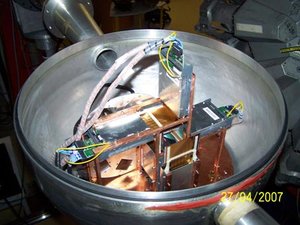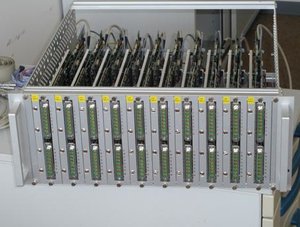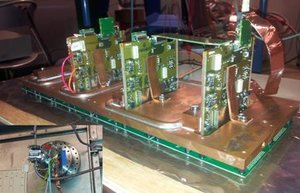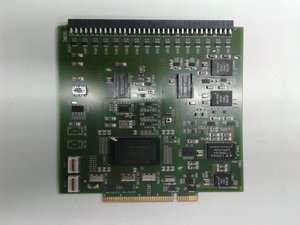DAQ
Responsible: GSI.
Work is performed within the DAQ Working Group.
Contact persons: Hans Tornqvist (DAQ) and Michael Heil (NeuLAND and TOFD electronics).
General Information
One of the main challenges of the R3B data acquisition System (DAQ) is to provide a maximum interoperability of the different detector systems and their associated DAQ sub-systems. To this goal, the data acquisition will be based on MBS – a distributed data acquisition system that provides a generalized multi-processor environment, suitable for the readout, control and data storage of heterogeneous setups based on common dead-time or time stamps. The present data acquisition and controls system of R3B/Cave-C serves as precursor and basis for developments for the later R3B experiment. Developments address the automated handling of large amounts of channels in view of e.g. pedestal determination and quality control, combining data acquisition and controls tasks. The distributed data acquisition system is supposed to run in parts in a time-synchronized distributed environment based on BuTiS and White Rabbit with timestamps with nano-second precision and 100ps/km accuracy.
The specific front-end electronics together with its digitization part are especially adapted to the individual detector system. As examples (see figures below), for Silicon Strip detectors the AMS front-end electronics have been made available through the locally developed Siderem module. The integrated multi-channel electronics for LAND is based on the TAC-27 ASIC chip TACQUILA and TRIPLEX card. For NeuLAND and TOFD, a new multichannel front-end electronic card TAMEX for high-resolution time and charge measurements has been designed by the GSI EE group and tested. The card is a combination of the existing LAND TACQUILA FEE and a FPGA TDC from the VFTX module. The readout electronics for a scintillator fibre tracking detector is based on the N-XYTER ASIC chip, being integrated into MBS by means of the GEMEX system board. The work is done in a close collaboration with the EE Group.
In order to generalize the readout of different data-sampling electronic modules commonly used in nuclear physics experiments, a unified, fast, easily and safely configurable library Nustar readout library (nurdlib) has been developed and made available for users.
The control, trigger and data flow are subsequently interfaced to the common Nustar DAQ (NDAQ) system. The front-end electronics provide various Hardware triggers such as physics triggers or calibration triggers which are handled accordingly by the advanced trigger logic TRLOII. This development in collaboration with Chalmers University turns the Vulom logic board into a powerful trigger module. For this we also work on integrated logic implementations e.g. TRLOII on the Vulom logic module.;
UPDATE tt_content SET bodytext=
A test of the R3B DAQ has been performed in 2014 during a detector test experiment S438.
Triggers and timestamps were distributed with TRIDI modules with the TRLO II firmware. Several standalone systems were running and writing large amounts of data to disk in parallel, and the event streams were merged off-line. The separate writing allowed for a peak data-rate of around 50 MB/s using the computing and networking infrastructure from earlier experiments. The event-streams were merged on-line from time to time to check data integrity but with a decrease in performance.
Diagnostics tools were developed to supervise all systems from one computer for efficient monitoring by physicists on shift. This setup proved successful with good results from analysis, and it was an important test for the even more demanding future experiments, where the White Rabbit timestamps will replace the TRLO II timestamps, and where even higher data rates from e.g. the CALIFA and Si recoil tracker detectors is expected.
July 2013
A new multichannel front-end electronic card TAMEX for high-resolution time and charge measurements has been designed by the GSI CSEE group and ordered. The card is a combination of the existing LAND TACQUILA FEE and a FPGA TDC from the VFTX module.
Literature
- "TRIPLEX, an Upgrade for the TACQUILA System", K. Koch et al, GSI Sci. Rep. 2010, PHN-IS-EE-07, p. 235.
- "Heading towards FAIR: upgrades on the R3B-Cave C electronics", C. Cäsar et al, GSI Sci. Rep. 2009INSTRUMENTS-METHODS-30, p. 310.







